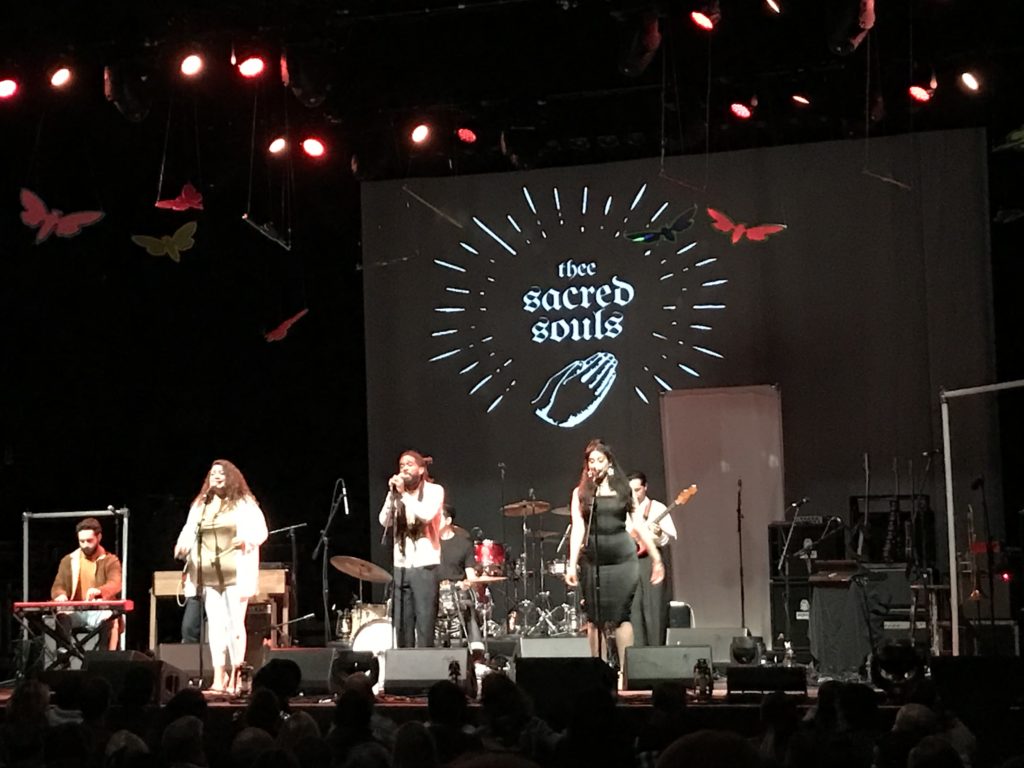
He spent the entirety of the following instrumental — inserted more to kill time than to showcase soloists — trying to get back onto the stage.
Known sometimes for wearing elaborate capes and shiny robes as if he were the most flamboyant white soul man since the Wayne Cochran, the portly Janeway, in his ballcap, beard, thick glasses and dark jacket (albeit with a colorful neon design on the back) looked more like fellow Alabamian Bocephus, Hank Williams Jr.
A once-aspiring preacher who was studying to become an accountant after community college, Janeway found he had a voice that could pretty much approximate Percy Sledge, topped with a falsetto as needed. Surrounded by fellow musicians from Birmingham, they recorded before they ever played live and got notice from their very first EP in 2012. Three years later, they were opening for The Rolling Stones and appearing at a slew of national TV shows and festivals.
As fun as it is to hear such energetically-played, horn-based R&B, their songs tend to deliver a lot of cliches, or songs that have no ideas at all, and are often interrupted by sudden tempo changes. One song was entirely interrupted as Janeway stopped the music when a fan down front signaled some kind of trouble. They resumed only after help came.
The band’s new album The Alien Coast, released in January, has more jarring turns to rock or stop and start pastiches of half-familiar soul (though they strictly do not cover the music that clearly inspired them).
D.C. was the fourth stop on their inaugural Alien Coast tour, so the setlist was packed with new material, saving some of the oldest and best known of their material to the end: The singalong of “Apollo” to end the main set, and “Like a Mighty River” and “Call Me” in the encore.
St. Paul and the Broken Bones is one band that may be heard best in the confines of their recordings; live they seem less precise and frankly, it feels odd in 2022 to experience a mostly white band play an entirely African-American art form to an overwhelmingly white audience.
The exception in the Broken Bones is a later hire, saxophonist Amari Ansari (who, like the rest of the horn section, was never well-amplified in the mix). But even so, that gives the Broken Bones the racial composition of, say, the E Street Band, or Hootie and the Blowfish.
A better approach to all of this may have been demonstrated by the opening band Thee Sacred Souls, a San Diego outfit making their D.C. debut.
Led by the sweet-voiced Josh Lane, the core group is technically a trio with guitarist-turned drummer Alex Garcia and bassist Sal Samano. Together they created the spare, tasty sound of the rhythm section that echoes the simple, direct approach of the retro but reverent acts on Daptone Records. Which makes sense, as they also record for a Daptone imprint and were produced by Bosco Mann.
On stage, they’re filled out as a five-piece with a couple of key backup singers, one of whom, Jensine Benitez, doubled down on the band’s Latin roots as she soloed on “Illusion De Amor” as Lane sat on a speaker and watched.
